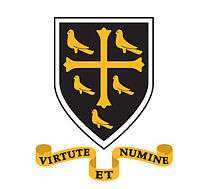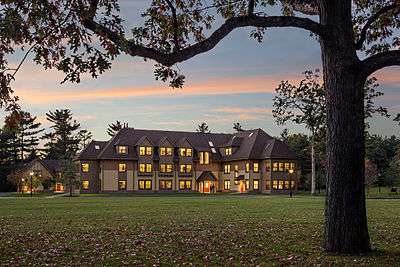Westminster School (Connecticut)
| Westminster School | |
|---|---|
 | |
| Location | |
| 995 Hopmeadow St, Simsbury, CT 06070 | |
| Information | |
| Type | Private, Boarding, Day |
| Motto |
Virtute Et Numine (Grit and Grace) |
| Established | 1888 |
| Headmaster | William V. N. Philip |
| Faculty | 86 |
| Enrollment | 390 |
| Color(s) | Black and Gold |
| Mascot | The Martlet |
| Website | www.westminster-school.org |
Westminster School is a selective, private boarding and day school located in Simsbury, Connecticut[1], accepting around 20% percent of applicants.
History

Westminster School was founded by William Lee Cushing in 1888 as a boys' school in Dobbs Ferry, New York.
In 1900, as enrollment increased, Cushing moved the school to its current location in Simsbury, Connecticut. The land had been donated through a trustee of the school, Arthur M. Dodge, a member of an old Hartford family. Williams Hill, the new site, offered more than 230 acres (0.93 km2) with views of the Farmington River. It also provided train service for students to New York and Boston.
A graduate of Yale University and a firm believer in the traditional form of English boarding school education, Cushing was strongly influenced by the Reverend Edward Thring, headmaster of Uppingham School in England.
In the early 1970s, Westminster School opened its doors to day students, and in 1971, girls were admitted to the school (first as day students and then, in 1977, as boarding students). Like many boarding schools, Westminster faced difficult times in the 1970s as it competed for a shrinking pool of boarding students. When Donald Werner retired in 1993, after serving as Headmaster for 21 years, he was succeeded by Graham Cole. During the Cole years, enrollment for the school grew from 340 to 385 students, with 88 faculty. Significant building projects undertaken included:
- Edge House. Designed by Westminster alumnus Graham Gund and built in 1996, Edge House houses 33 students and three faculty families.[2]
- Kohn Squash Pavilion. Completed in the Spring of 2000, The Squash Pavilion contains eight squash courts around a stepped viewing area with natural light from skylights above. The team rooms, locker rooms, and other support spaces are located on a second floor mezzanine overlooking the viewing area and squash courts below.
- Sherwin Health & Athletic Center. Completed in 2003, the Sherwin Health & Athletic Center, the Hibbard Aquatic Center and the Health & Counseling Center is a multipurpose building. The Aquatic Center contains a competition pool with support facilities and a viewing area on the mezzanine floor.[3]
- Armour Academic Center. This 85,000-square-foot Center houses the Humanities, Math and Science departments, library, and administration. Building features include a centrally located atrium, two-story library, classrooms and laboratories, 120-seat lecture hall, planetarium, faculty and administrative offices, and a variety of lounge spaces.[4]
With Cole's retirement in 2010, Westminster appointed William V.N. Philip as its eighth Headmaster. Philip ascended to the top job after a 26-year career at Westminster as a teacher, coach, dormitory parent, college counselor, and most recently Associate and Assistant Headmaster.[5]
Faculty and staff
Headmasters
- William Lee Cushing (1888–1920), first headmaster and school founder[5]
- Lemuel Gardner Pettee (1920–1922), school faculty member for over 50 years and namesake of one of the school's gymnasiums
- Raymond McOrmond (1922–1936), namesake of a faculty home
- Arthur Milliken (1936–1956)
- Francis Keyes (1956–1970),[6] namesake of the Admission and Development building
- Donald H. Werner (1970–1993), namesake of the Centennial Center, home to most of the arts on campus
- W. Graham Cole, Jr. (1993–2010), namesake of the school's library[7]
- William V.N. Philip (2010 -)[8]
Student activities
Athletics
All Westminster students participate in an afternoon program during each term of the school year. The emphasis is on athletics; however, the afternoon commitment can include drama, stagecraft, dance, community service or another independent study project. The afternoon program is designed to encourage Westminster core values: community, character, balance and involvement.
Westminster's sports and recreation facilities include 35 acres of playing fields, 14 tennis courts, a 400-meter synthetic track, eight international squash courts, an indoor hockey rink, a new lighted synthetic turf field, baseball and softball fields, basketball courts and a state-of-the-art aquatic center that includes an eight-lane, 25-yard swimming and diving pool, a well-equipped fitness room and our professionally staffed health center.[9]
| Sport | Season | Boys/Girls | Competitive |
|---|---|---|---|
| Cross Country | Fall | B/G | Yes |
| Field Hockey | Fall | G | Yes |
| Soccer | Fall | B/G | Yes |
| Water Polo | Fall | B | Yes |
| Basketball | Winter | B/G | Yes |
| Ice Hockey | Winter | B/G | Yes |
| Squash | Winter | B/G | Yes |
| Swimming and Diving | Winter | B/G | Yes |
| Baseball | Spring | B | Yes |
| Golf | Spring | B/G | Yes |
| Lacrosse | Spring | B/G | Yes |
| Softball | Spring | G | Yes |
| Tennis | Spring | B/G | Yes |
| Track and Field | Spring | B/G | Yes |
A student tradition, dating as far back as the 1920s, is stickball, a game in which teams made up of dormitory floors and day student teams compete in a baseball-like game on the quad and athletic fields in late spring.[10] Each floor makes its own bat, usually a hockey or lacrosse stick that has been cut, or a wooden dowel of a large diameter. Generally the stickball "season" will culminate in a single-elimination tournament to crown the Hill Stickball champion.
Theater
Each year the theater program stages three productions in the Werner Centennial Theater: one dramatic production spanning the varied genre of Western theater, a musical production, and the student-directed performances, which offer advanced students the opportunity to direct. Each of these productions offers many opportunities for student involvement and leadership, both on stage and backstage.[11]
Situated at the northeastern corner of the campus’s central quadrangle, Centennial Center was upgraded in 1988 into a 30,000 square-foot building including a two-story lobby, a 400-seat, multi-use Shakespearean-style theater, music and dance studios and rehearsal room, dressing rooms, a scene shop/laboratory and other production support spaces. Particular to the “courtyard” theater form, all 400 seats are within 40 feet of the front of the stage, and there is built-in flexibility for both audience size and style of production.[12]
Campus facilities
Dormitories
- Cushing Hall - 1900 (originally named Main Building)
- Memorial Hall - 1928 (remodeled in 1998)
- Alumni House - 1973
- Edge House - 1996
- Squibb House - 2013
- Gund House - 2013
- Kelter House - 2017
Academic / Arts facilities
- Hamilton Art Studios (houses studio art and architecture classrooms)
- Werner Centennial Center & Theater - 1989[13] (houses theater, dance studios, band/music rooms, practice rooms, and scene and prop shops)
- Armour Academic Center - 2009
Athletic facilities
- Pettee Gymnasium
- Jackson Hockey Rink
- Hovey Field - 2012
- Kohn Squash Pavilion - 2001
- Sherwin Health and Aquatic Center - 2005
- Michelini Field and Brooks Family Track
- Osborn Baseball Field
- Wilbraham Field, Harrison Field, Sawyer Field, and other multi-purpose sports fields
- Gow and Haynes Tennis Courts
Other on-campus facilities
- Andrews Memorial Chapel - 1961
- Armstrong Dining Hall - 2017
- Brockelman Student Center - 2018
- Barnes-Bristow Observatory
Former buildings
- Hay Chapel - 1909-1961
- East Cottage - unknown-2008
- Baxter Academic Center - 1964-2009
- Original Squibb House - demolished 2013
- Andrews Dormitory - demolished 2013
- Timken Student Center
Alumni
Notable alumni include:
- Lake Bell '97, actress
- Eric Boguniecki, NHL Hockey player
- Ethan Brooks '91, NFL Football player
- Joy Bryant '92, actress
- Tommy Cross '08, Boston Bruins 2nd round draft pick and currently with the Columbus Blue Jackets
- David Doubilet '65, National Geographic photographer
- Jack Du Brul, writer
- Andrew Firestone, The Bachelor TV series
- Peter Fonda, actor
- Bryan Nash Gill, '80, artist
- Graham Gund '59, architect
- Alec Musser, actor
- Ben Smith '06, NHL Hockey player[14]
- John V. Tunney '52, former United States Senator and Representative from the state of California
- Wellesley Wild '90, writer and executive producer of Family Guy
References
- ↑ "Westminster School Profile | Simsbury, Connecticut (CT)". Boardingschoolreview.com. 2013-10-28. Retrieved 2013-11-17.
- ↑ "Simsbury Prep School Gets Gift Of $27 Million" (Web article). The Hartford Courant. September 21, 1996.
- ↑ "Sherwin Health & Academic Center" Gund Partnership, Hibbard Aquatic Center, Sherwin Health & Athletic Center and Kohn Squash Pavilion
- ↑ "Armour Academic Center" Gund Partnership, Armour Academic Center, Westminster School
- 1 2 "Westminster School History". Westminster School website. Accessed 23 March 2012.
- ↑ Francis Keyes, a Headmaster at Westminster School, Dies. New York Times, Dec 13, 1981; p.54.
- ↑ Buck, Rinker. "The Westminster School Names New Headmaster". The Hartford Courant. Hartford Courant. Retrieved 16 March 2015.
- ↑ "A Biography of Board Member William V.N. Philip". National Network of Schools in Partnership. National Network of Schools in Partnership. Retrieved 16 March 2015.
- ↑ "Westminster Athletics". Westminster-school.org. Westminster School. Retrieved 23 March 2015.
- ↑ Baron, Peter. "A Guided Tour of Westminster School". Admissions Quest. Admissions Quest. Retrieved 16 March 2015.
- ↑ "Westminster School ~ Theater". Westminster-school.org. Retrieved 2013-11-17.
- ↑ "Centennial Performing Arts Center, Westminster School". Gund Partnership. Retrieved 16 March 2015.
- ↑ Anderson, Grace. "Theatrical romance." Architectural Record 178.n9 (August 1990): 90(2).
- ↑ Fitts, John. "Avon's Ben Smith Brings Hockey's Famed Stanley Cup to Westminster School". Avon Patch. Patch. Retrieved 16 March 2015.
Further reading
- Rinker Buck. Enrollment Shift Could Burden Farmington Valley Towns: From Private to Public Schools. Hartford Courant, 25 Mar 2009.
- The True Life: Westminster School 1989-2013 by Charles E. Griffith III
- Westminster School Viewbook: A Guide to Westminster School